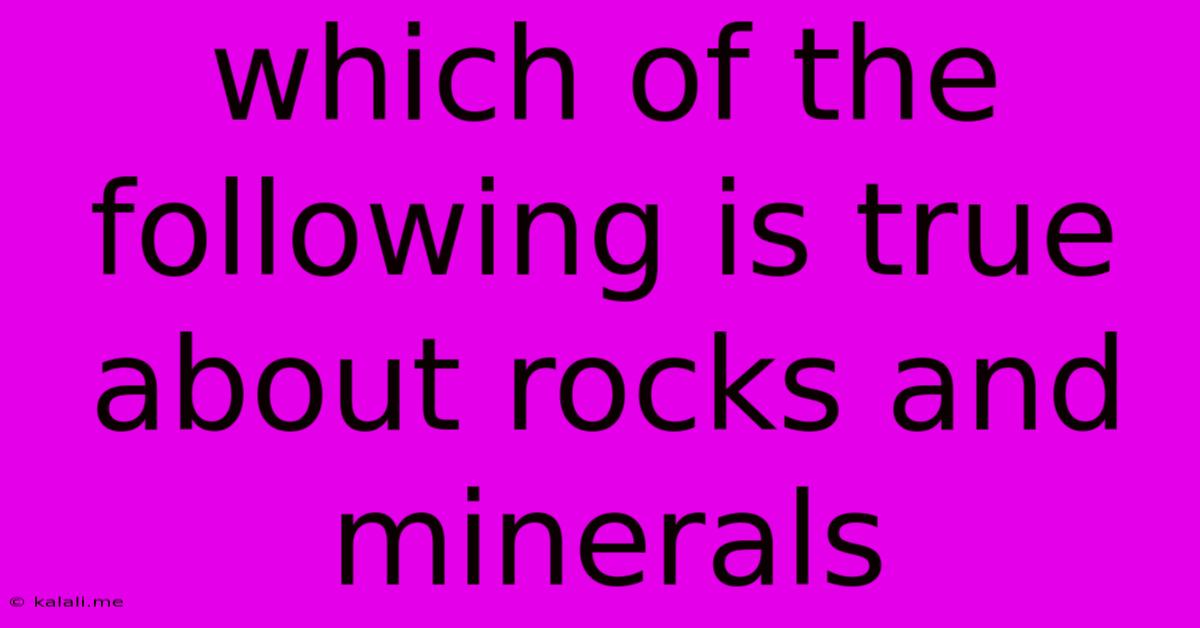Which Of The Following Is True About Rocks And Minerals
Kalali
Jun 14, 2025 · 3 min read

Table of Contents
Which of the Following is True About Rocks and Minerals? A Comprehensive Guide
Rocks and minerals are fundamental components of the Earth's crust, often used interchangeably, but possessing distinct characteristics. Understanding their differences is crucial for anyone studying geology, Earth science, or simply appreciating the natural world. This article clarifies the relationship between rocks and minerals, addressing common misconceptions and providing a comprehensive overview of their properties. This will help you answer the question: which of the following is true about rocks and minerals?
What are Minerals?
Minerals are naturally occurring, inorganic solids with a specific chemical composition and a highly ordered atomic arrangement (crystalline structure). This means they are not made by living things and have a defined internal structure that repeats itself in a three-dimensional pattern. Key characteristics include:
- Naturally occurring: They are formed by geological processes, not manufactured.
- Inorganic: They are not derived from living organisms.
- Solid: They maintain a definite shape and volume at room temperature.
- Specific chemical composition: Each mineral has a specific chemical formula, although there can be some variation. For example, quartz is always SiO₂.
- Ordered atomic arrangement: The atoms within a mineral are arranged in a highly ordered, repeating pattern, creating a crystalline structure. This often results in distinct geometric shapes (crystals).
Examples of minerals include quartz, feldspar, mica, and calcite. Each has a unique combination of physical and chemical properties, such as hardness, color, luster, and cleavage.
What are Rocks?
Rocks are naturally occurring aggregates of one or more minerals. Unlike minerals, rocks don't have a fixed chemical composition. They are formed through a variety of geological processes, and their composition can vary significantly depending on their origin and the minerals present. Think of rocks as a collection of minerals "glued" together. We classify rocks into three main categories based on their formation:
- Igneous rocks: Formed from the cooling and solidification of molten rock (magma or lava). Examples include granite and basalt.
- Sedimentary rocks: Formed from the accumulation and cementation of sediments (fragments of other rocks, minerals, or organic materials). Examples include sandstone and limestone.
- Metamorphic rocks: Formed from the transformation of existing rocks (igneous, sedimentary, or other metamorphic rocks) due to heat, pressure, or chemical reactions. Examples include marble and slate.
The Relationship Between Rocks and Minerals
The relationship is fundamental: rocks are made up of minerals. A single rock can contain many different minerals, while some rocks might be composed primarily of one mineral. For example, a rock consisting almost entirely of quartz is called quartzite. Conversely, a single mineral can be found in many different types of rocks.
Common Misconceptions
It's crucial to avoid common misconceptions:
- Minerals aren't rocks: While minerals are components of rocks, they are distinct entities with their own defining characteristics.
- Rocks aren't always made of many minerals: Some rocks are almost entirely composed of a single mineral.
- All rocks have the same formation process: The three major rock types (igneous, sedimentary, metamorphic) have distinct formation processes.
Which of the Following is True About Rocks and Minerals? Possible Answers and Explanations
Without a specific "following" to choose from, we can address several true statements comparing rocks and minerals:
- Rocks are composed of minerals: This is fundamentally true.
- Minerals have a defined chemical composition, while rocks do not: This highlights the key difference between the fixed composition of minerals and the variable composition of rocks.
- Rocks can be formed through various geological processes, whereas minerals are formed through specific geological processes: This underscores the different formation mechanisms.
- Minerals have a crystalline structure, while rocks may or may not have a dominant crystalline structure: This highlights the ordered atomic arrangement in minerals.
In conclusion, understanding the distinction between rocks and minerals is essential for grasping fundamental geological concepts. Rocks are collections of minerals, and their properties are determined by the types and proportions of minerals they contain. Remembering this fundamental relationship will help answer any question comparing the two.
Latest Posts
Latest Posts
-
How Many Ways Are There To Save A Document
Jun 15, 2025
-
What Is The Difference Between Subordinating And Coordinating Conjunctions
Jun 15, 2025
-
The Meaning Of Words And Sentences Is Called
Jun 15, 2025
-
Device That Converts Mechanical Energy Into Electrical Energy
Jun 15, 2025
-
What Is The Lcm Of 36 And 45
Jun 15, 2025
Related Post
Thank you for visiting our website which covers about Which Of The Following Is True About Rocks And Minerals . We hope the information provided has been useful to you. Feel free to contact us if you have any questions or need further assistance. See you next time and don't miss to bookmark.